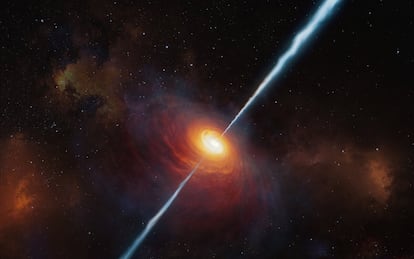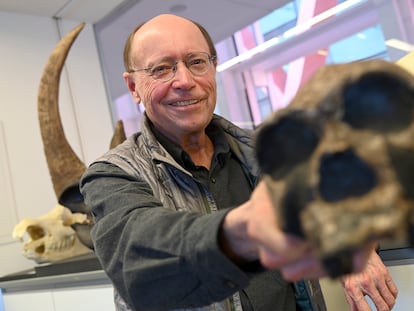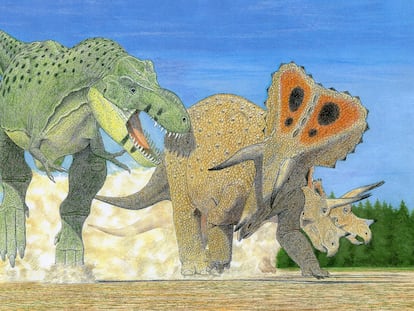When reality defies common sense
Things don’t always seem smaller the farther away you get. It’s a strange phenomenon of astrophysics that doesn’t correspond to our everyday experience

If a majority of people think one way, that’s the way things are, right? But mathematics isn’t democratic, and neither is physics. Reality, by extension, does not behave in the way we think it should based on our very limited and biased experience. We are going to explore how intuition sometimes fails.
Let’s say I find myself in front of the Sagrada Familia in Barcelona, at the foot of this imposing and beautiful work of architecture. It gives me a stiff neck just thinking about trying to see the entire thing looking up from the main doorway. It almost occupies my entire field of vision, and I can only take a picture with a wide angle lens. I want to see it better, so I move a little further away to get a better perspective. In order to be able to take a photo with my cellphone, I move a tiny bit more. The further away I am, the smaller the grand Basilica seems to me. Common sense: things seem smaller the further away they are.
Presenting this in a slightly more mathematical way, the angle that two segments form as they move from the extremes of an object and join at one point – in my eye – gets smaller and smaller as the segments get longer and longer. This is known as angular size. But is that always true? I wouldn’t be writing an article if the answer was yes, so obviously it’s a lie: things that are further away don’t always seem smaller. In fact, after a certain distance (of astronomic dimensions), the further away you get, the bigger things seem. The angle where they meet grows with distance. Impossible! Wait, I’ll explain.
The Andromeda Galaxy, our older sister, is double the size of our galaxy, at some 220,000 light years in size. Today we see it in the sky (with telescopes, as the naked eye doesn’t allow us to see it completely) with an angular size about six times larger than that of the sun.
Andromeda seems small to us, so let’s talk about something larger, the largest thing we know. If we want to see everything in the universe today – the so-called observable universe – we have to look in all directions in the sky. Now, since the universe has been expanding during the entire span of time since the Big Bang, our observable universe, which is about 90,000 million light years in diameter, was smaller in the past.
If we continue going backwards, all of today’s observable universe had a size of 220,000 light years around the time it turned one year old (note for the sticklers: I haven’t said that the whole universe was this size). Back then, Andromeda didn’t exist, nor did galaxies, nor even did the oxygen that we breathe or the carbon of our DNA. There were only protons, electrons, helium nuclei, a few lithium nuclei, and a lot of photons bumping into everything that moved. In that moment, one year after the Big Bang, the size of Andromeda was the same as that of the whole universe that we know today.
If our sister galaxy had existed, it would have occupied the sky for a contemporary observer. What we now see with an angular size that we can block out with two fingers would have covered the whole astral dome. An object of exactly the same physical size that existed a year after the Big Bang would today appear larger in the sky, even if it were further away. That object would have grown today to the size of the observable universe. It would no longer be today’s Andromeda! It’s a little tricky, but the fact that the universe is expanding, that the distance to Andromeda this morning is five million kilometers greater because space-time is changing, is also a bit anti-common sense.
I hear you cry: “You’re inventing this, it has to be a lie, it’s not common sense!” Every scientist should be a skeptic. But in science, you should include proof, even to debunk a lie. The results of various astronomical experiments support this mind-bending property of an expanding universe. The key to these experiments is to find a good constant that has existed for thousands of millions of years, something that hasn’t changed size during the eons that the galaxies have seen pass by. This cosmic constant should also be very bright and of considerable size, so that we can see it from far and wide.
This type of constant is found in something that we can’t see directly because nothing, not even light, escapes its gravitational field. We’re talking about black holes, and not just any black holes, but the biggest ones in existence: supermassive black holes. These cosmic bodies sometimes capture nearby material, and before swallowing it heat it up to millions of degrees Celsius, making them super bright. These are called quasars. The nucleus of the quasar, the innermost part of these cosmic monsters, is pretty compact at 36 light years. The zone of a supermassive black hole has a mass equivalent to hundreds of millions of suns, instead of a few dozen in the case of our solar neighborhood.
Cosmic constant
The exact size of a quasar’s nucleus is fairly predictable, so they seem like a good cosmic constant. Observing these very bright objects, which are detectable even at the ends of the universe, we have found that the further away they are, the smaller their angular size, but this is only true up to 40 billion light years of distance. The compact quasar nuclei that are further away than that suddenly begin to seem bigger to us, in defiance of common sense, but following the physical rules of the universe.
We conclude that sometimes one must separate oneself from things to see their full grandeur, and that there’s no such thing as common sense; any event in the universe, or on Earth or in our country, can seem normal or rather, impossible. But because a large part of our experience and understanding of reality is (very?) limited, we need to open our eyes to what seems to us to be irrational, to interpret it, and make use of it.
Tu suscripción se está usando en otro dispositivo
¿Quieres añadir otro usuario a tu suscripción?
Si continúas leyendo en este dispositivo, no se podrá leer en el otro.
FlechaTu suscripción se está usando en otro dispositivo y solo puedes acceder a EL PAÍS desde un dispositivo a la vez.
Si quieres compartir tu cuenta, cambia tu suscripción a la modalidad Premium, así podrás añadir otro usuario. Cada uno accederá con su propia cuenta de email, lo que os permitirá personalizar vuestra experiencia en EL PAÍS.
¿Tienes una suscripción de empresa? Accede aquí para contratar más cuentas.
En el caso de no saber quién está usando tu cuenta, te recomendamos cambiar tu contraseña aquí.
Si decides continuar compartiendo tu cuenta, este mensaje se mostrará en tu dispositivo y en el de la otra persona que está usando tu cuenta de forma indefinida, afectando a tu experiencia de lectura. Puedes consultar aquí los términos y condiciones de la suscripción digital.











































